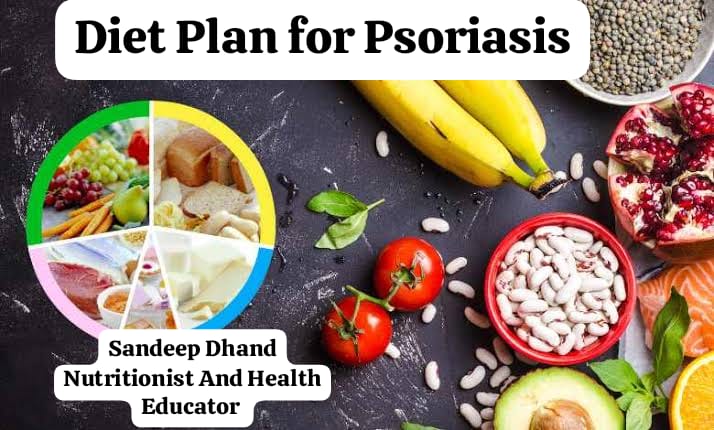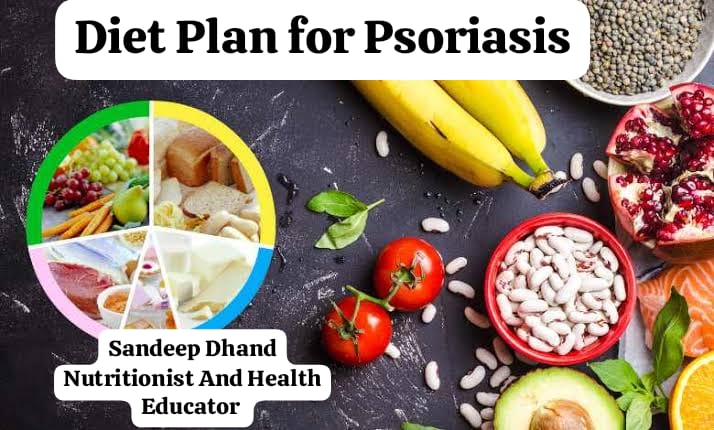Sandeep Dhand
Nutritionist And Health Educator
Diet plays a crucial role in managing psoriasis symptoms. Although there is no specific “psoriasis diet,” certain foods can help reduce inflammation, strengthen the immune system, and improve skin health. Below is a diet plan designed to help people with psoriasis:

Diet Plan for Psoriasis
Key Principles:
Anti-Inflammatory Foods: Focus on foods that reduce inflammation in the body.
Rich in Antioxidants: Include fruits and vegetables to fight oxidative stress.
Healthy Fats: Incorporate omega-3 fatty acids for their anti-inflammatory properties.
Low in Processed Foods: Avoid refined sugars, trans fats, and processed foods.
Sample Daily Diet Plan
Morning (Upon Waking)
Drink:
Warm water with lemon (detoxifies and hydrates).
Alternatively, green tea with a teaspoon of honey.
Breakfast (7:30 AM – 8:30 AM)
Option 1:
Oatmeal topped with chia seeds, flaxseeds, and fresh blueberries.
A handful of walnuts or almonds.
Green smoothie (spinach, cucumber, apple, and ginger).
Option 2:
Whole-grain toast with avocado spread.
A boiled egg or scrambled tofu.
Herbal tea or black coffee (avoid sugar).
Mid-Morning Snack (10:30 AM – 11:00 AM)
Options:
A small bowl of fresh fruits (papaya, pomegranate, or apple).
A handful of pumpkin seeds or sunflower seeds.
Lunch (1:00 PM – 2:00 PM)

Main Meal:
Grilled fish (like salmon or mackerel) or a plant-based protein like chickpeas or lentils.
Quinoa, brown rice, or whole-grain bread.
Steamed or roasted vegetables (broccoli, carrots, zucchini).
A small green salad with olive oil and lemon dressing.
Drink:
A glass of buttermilk or coconut water.
Afternoon Snack (4:00 PM – 4:30 PM)
Options:
A handful of mixed nuts (almonds, walnuts, or pistachios).
A small bowl of yogurt with a dash of cinnamon.
Dinner (7:00 PM – 8:00 PM)
Main Meal:
Grilled chicken or tofu stir-fry with vegetables (spinach, bell peppers, and mushrooms).
Sweet potato or a small portion of brown rice.
A bowl of vegetable soup (tomato, carrot, or pumpkin).
Bedtime Snack (9:30 PM – 10:00 PM)
Options:
A cup of warm turmeric milk (anti-inflammatory).
A small piece of dark chocolate (85% or higher cocoa).
Foods to Include
- Fruits and Vegetables:
Leafy greens (spinach, kale, broccoli).
Berries (blueberries, strawberries).
Orange and yellow veggies (carrots, sweet potatoes).
- Healthy Fats:
Fatty fish (salmon, mackerel, tuna).
Olive oil, flaxseeds, chia seeds, and walnuts.
- Whole Grains:
Brown rice, quinoa, oats, and whole-grain bread.
- Protein Sources:
Lean meats, eggs, legumes, and tofu.
- Herbs and Spices:
Turmeric, ginger, and garlic (natural anti-inflammatories).
- Probiotics:
Yogurt, kefir, and fermented foods (like kimchi or sauerkraut).
Foods to Avoid
- Processed Foods:
Chips, cookies, and packaged snacks.
- Red Meat and Saturated Fats:
Avoid excessive consumption of red meats and fatty cuts.
- Dairy:
High-fat dairy products may worsen inflammation.
- Refined Sugars:
Sweets, pastries, and sugary drinks.
- Gluten (if sensitive):
Some individuals with psoriasis benefit from reducing gluten.
- Alcohol:
Can trigger flare-ups and reduce the effectiveness of treatments.
Hydration Tips
Drink plenty of water throughout the day to keep your skin hydrated.
Herbal teas (chamomile, green tea) are excellent alternatives.
Additional Tips
- Monitor Your Triggers: Keep a food diary to track which foods might trigger flare-ups.
- Balanced Meals: Focus on moderation and ensure your meals are nutritionally balanced.
- Consult a Nutritionist: If unsure, seek professional advice for a tailored plan.
By following this diet plan and avoiding potential triggers, you can help reduce psoriasis symptoms and improve your overall well-being.